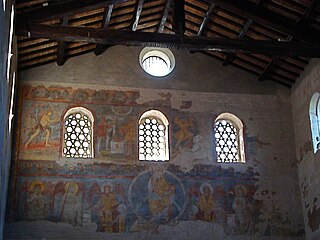San Giovanni a Porta Latina
San Giovanni a Porta Latina ( Latin : Sancti Ioannis ante Portam Latinam ) is a basilica near the Porta Latina in Rome . It is located on the inner-city section of the Via Latina , within the Aurelian Wall .
Building history
Under Pope Gelasius I (492–496) the first church was built around 490, probably influenced by the cult in honor of the evangelist John that was introduced in Rome at that time . Because there are no building news, the dating must be based on found roof tiles from the 5th century and the archaeological investigation of the building fabric. It is a south-east facing nave basilica with porch (about 31 m long), a relatively wide central aisle (7.5 m) and narrow aisles (2.7 m), separated by six arcades on five Spoliensäulen of granite and white Marble with Ionic capitals . The central nave transitions into a transverse rectangular vestibule and an apse with three large arched windows; An architectural feature of Rome is that the apse is semicircular on the inside and polygonal on the outside . At the level of the vestibule, the side aisles open into side rooms, which are closed off with small apses. These so-called pastophoria were used to lay the offerings ( prothesis ) and to store the liturgical vestments and utensils ( diakonicon comparable to sacristy ); they are characteristic of the Byzantine church building , which obviously served as a model for this small basilica. Comparable Byzantine architectural features can also be found at Santa Maria Antiqua . The central nave and side aisles had an open roof.
The forecourt with a fountain was laid out as early as the 9th century; the fountain bears an early medieval inscription with the name of the sculptor “Stephanus”, who left the earliest master's sign of this era. In the years after 1050, the nave and vestibule were rebuilt on the old foundations and to the same extent using many components from the old building, as recent building studies have shown. The three apses, vestibule and pastophoria as well as parts of the wall on the left outer wall were preserved from the early Christian basilica. A dedicatory inscription tells us that the church was consecrated again after the construction work was completed in 1191 by Pope Celestine III. has been made. The campanile , begun in the 11th century, was not completed until the 12th century.
The vestibule ( narthex ) dates from the 12th century; The four Ionic columns are ancient Spoli columns. On the right inner wall, the remains of the barrier plates of the Schola cantorum are walled in with particularly good stone carving (around 1200).
The changes to the exterior and interior made during the 16th to 19th centuries were removed in the 20th century in order to restore the basilica to its medieval state.
Church interior
The particularly high-quality wall paintings on the interior walls from around 1200 were rediscovered in 1914 and then restored. The cycle consists of 46 individual images in three registers one above the other. The uppermost picture strip begins on the right-hand tall nave wall at the top left and runs all around over the entrance wall and the left side wall to the triumphal arch . Below that are two more registers with a recess for the entrance wall. In the cycle, scenes from the Old and New Testament alternate. On the entrance wall, in the upper register, the story of Cain and Abel and below Christ as the judge of the world between angels is shown. The apocalyptic lamb between the four evangelist symbols has been preserved (heavily damaged) on the triumphal arch wall . Nothing is known about the original painting of the apse. In the pastophoria there are remains of frescoes from the end of the 8th century.
Cardinal priest
San Giovanni a Porta Latina was elevated to the title church of a cardinal priest by Pope Leo X in 1517 . Among them are the Cologne Archbishops Felix Cardinal von Hartmann (1914-1919) and Josef Cardinal Frings (1946-1978).
literature
- Giovanni Mario Crescimbeni: L'Istoria della chiesa di S. Giovanni avanti Porta Latina , Rome 1716.
Web links
Individual evidence
- ^ Hugo Brandenburg: The early Christian churches in Rome from the 4th to the 7th century , Regensburg 2013, p. 238ff.
- ↑ Hans Georg Wehrens: Rome - The Christian Sacred Buildings from the 4th to the 9th Century - Ein Vademecum , Freiburg 2016, p. 281.
- ^ Peter Cornelius Claussen: The churches of the city of Rome in the Middle Ages 1050-1300 , Volume 3, Stuttgart 2002-2010, p. 153ff.
- ^ Walter Buchowiecki: Handbook of the Churches of Rome. The Roman sacred building in history and art from early Christian times to the present. Volume 2, Vienna 1970, p. 123f.
Coordinates: 41 ° 52 ′ 38 ″ N , 12 ° 30 ′ 7 ″ E





